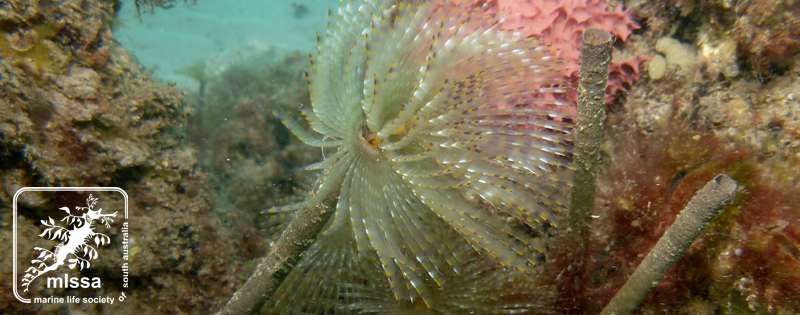South Australian divers may have heard a little bit about the introduction of exotic species into Australian waters. It is said to be an increasing problem but we do not see much evidence of it in SA waters.
Fortunately, we have not yet seen anything of the large Northern Pacific Seastar which is decimating Tasmania’s marine life. There is, however, one introduced species that seems to be rapidly establishing itself in our waters. It is the European Featherduster Worm (which is also known as the Sabellid Fan Worm). This worm could pose a major threat to our native marine life.
The European Featherduster Worm is a feral *Annelid worm which has recently been introduced into Australian waters. It is thought that it may have been carried into our country as hull fouling on ships from overseas. As a port, the area of Port Adelaide is highly susceptible to such introductions.
The worm has established itself in the Port River, the West Lakes system, Largs Bay jetty and around North Haven. They can also be seen at the West Lakes inlet off of Grange. Sightings have been reported from Nepean Bay, Kangaroo Island and Rapid Bay.
They are very similar to the Featherduster worms that have long been common in SA waters but they become more prolific once they are established. They grow quickly and reach their maximum length in about one year. They produce large numbers of eggs which develop into free-swimming larvae. They are also able to regenerate large portions of their bodies.
Concerned divers have thought of slashing them to pieces to reduce their numbers but, because of their regeneration abilities, it would make things worse. Their numbers would only increase at a greater rate.
*An Annelid worm is one that belongs to the phylum Annelida. Segmented marine worms, earthworms and leeches all belong to this phylum. Each of these, however, come from a different Class.
Featherduster worms are segmented worms which belong to the Class Polychaeta. (“Marine Invertebrates of Southern Australia – Part I” includes a chapter on Polychaete bristleworms (Chapter 6, p.228).) Polychaete comes from Greek for “many hair” and Annelida comes from Latin for “a ring”.
The European Featherduster belongs to the Order Sabellida, the Family Sabellidae and its scientific name is Sabella spallanzanii.
The full classification of the European Featherduster then is as follows:-
Phylum Annelida
Class Polychaeta
Order Sabellida
Family Sabellidae
Genus Sabella
species spallanzanii
The Scuba Divers Federation of SA recently purchased a copy of “A Guide to the Introduced Marine Species in Australian Waters”. It is a CRIMP handbook, published by the Centre for Research on Introduced Marine Pests at the CSIRO Marine Laboratories, Hobart, Tasmania.
The ring-folder guide has a page on Sabella spallanzanii featuring a photograph and a diagram. It describes much of the above in detail and says that the worm’s known distribution includes Devonport, Tasmania, Port Phillip Bay, Victoria, Cockburn Sound, Fremantle, Bunbury Harbour and Albany Harbour, WA and Gulf St Vincent, SA. The guide also says that the worm poses a threat to scallop fisheries through bottom fouling.
An article in The Advertiser said that the European Featherduster Worm was discovered in Port Phillip Bay, Victoria in the mid-1980’s. It decimated the scallop fishing industry there by forming large mats which smother other sea life and competes with them for food. A quarter of Port Phillip Bay is estimated to have the worm. The bay is said to be 2000 sq km so the worm is covering some 500 sq km of the bay.
Jenny Sampson wrote about the European Featherduster Worm in the May and June 1996 issues of the newsletter of the Coastal Waters Dive Club. Jenny’s two-part article told of the worm’s origin and described the worm in detail. It also described spawning, regeneration, preferred habitat, impact and potential for spreading by hull fouling. It also says that the worm has no known predators. The first part of the article included diagrams and explained much of the terminology used in the description part.

